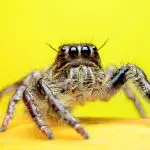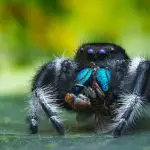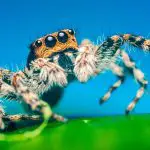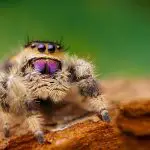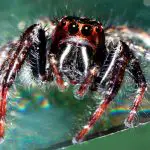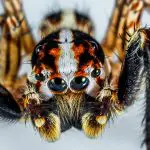Last updated on July 5th, 2023 at 03:01 pm
What do Baby jumping spiders eat? Most of them eat the same prey as adults, just smaller ones. Interestingly, some also eat nectar though…
Jumping spider babies consume more prey than adults. Though small insects are the prey, babies consume insects exactly like adults do. Even though they are primarily carnivorous, young jumping spiders also consume nectar, making them omnivores. For very young baby jumping spiders, wingless Drosophila fruit flies are the best prey.
Once baby Jumping spiders have grown a little, then they can move onto any of the following:
- baby roaches
- pinhead crickets
- small waxworms
- small mealworms
- maggots
- blowflies
Can baby jumping spiders eat ants?
Baby spiders seldom eat ants. These ants have strong defenses, they sting painfully and even paralyze victims with a chemical spray called formic acid making them a risky meal for the spiders.
What can baby jumping spiders eat?
Despite the lack of breasts on these spiders, kids nevertheless sip milk, which emerges from apertures on their mother’s stomach. Female spiders use these identical apertures to lay their eggs.
Researchers claim that the milk is four times more protein-rich than cow milk and is full of minerals. Sugar and lipids are among the milk’s additional nutrients.
A single female spider can lay from two to 36 eggs. Until they are a little bigger, stronger and can suckle from the mother’s gastric furrow, the small baby spiders feed on the milk droplets.
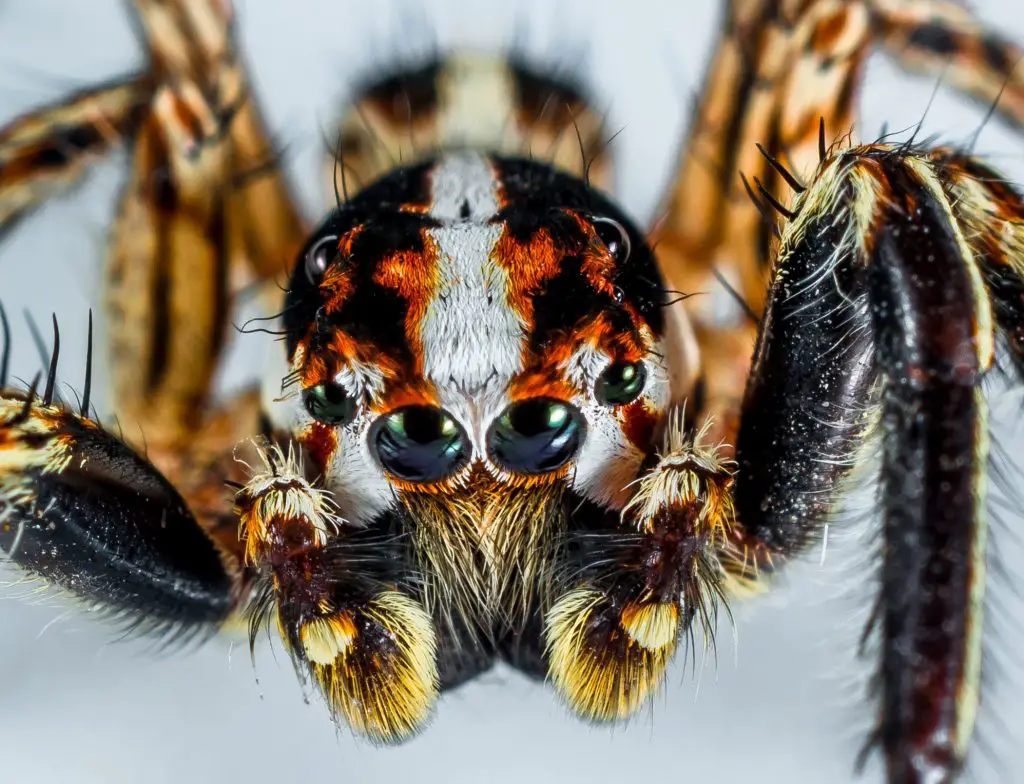
Will jumping spiders eat dead insects?
The majority of jumping spiders often consume living insects only, like small crickets, flies, and moths. The spider eats anything that moves, but not dead insects.
Do jumping spiders eat rolly pollies?
Yes, they do. Rolly pollies are good source of nutrition to jumping spiders. That said, I wouldn’t go out and catch rolly pollies for my spiders.
Wild invertebrates often carry parasites and diseases, so I always opt for captive-reared feeder bugs. Your spider will get just as much nutrition safely from farm reared fruit flies, crickets, or mealworms, for example.
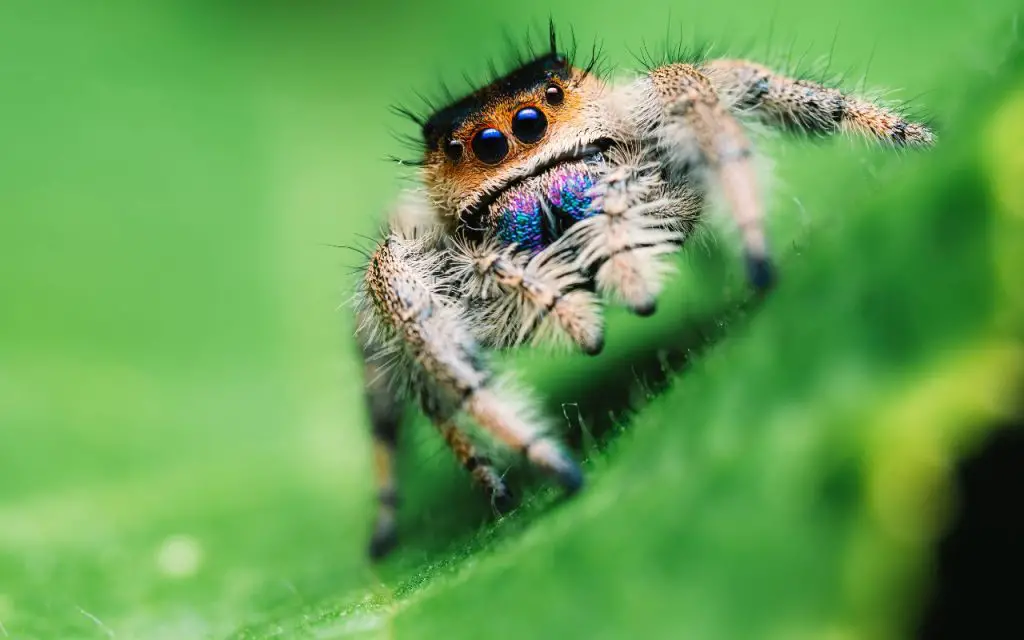
What do jumping spiders like to eat?
Jumping spiders consume pretty much anything they can in the wild! They are active hunters that are regularly observed eating all of the following:
- bed bugs
- brown recluses
- black widows
- ants
- aphids
- ladybugs
- rolly pollies
- beetles
- large crickets
- caterpillars
- butterflies
- cockroaches.
Jumping spiders also consume earwigs, centipedes, grasshoppers, monarch caterpillars, daddy long legs, fleas, earthworms, flies, fightless fruit flies, and isopods.
In addition, mealybugs, mosquitoes, June bugs, millipedes, pill bugs, maggots, mites, moths, pincher bugs, slugs, roaches, stink bugs, ticks, snails, and worms can all become jumping spiders’ prey.
The spiders can also eat fish, thrips, green tree ants, silverfish, wasps, springtails, wax worms, woodlice, worms, and spider mites.
Jumping spiders are able to consume plants, since certain species of jumping spiders do take nectar from plants. These spiders may eat some plants, but since they are carnivores, they prefer to devour tiny insects and mammals.
After mating, jumping spiders also frequently consume their partners. In fact, they won’t think twice about eating each other if the chance arises.
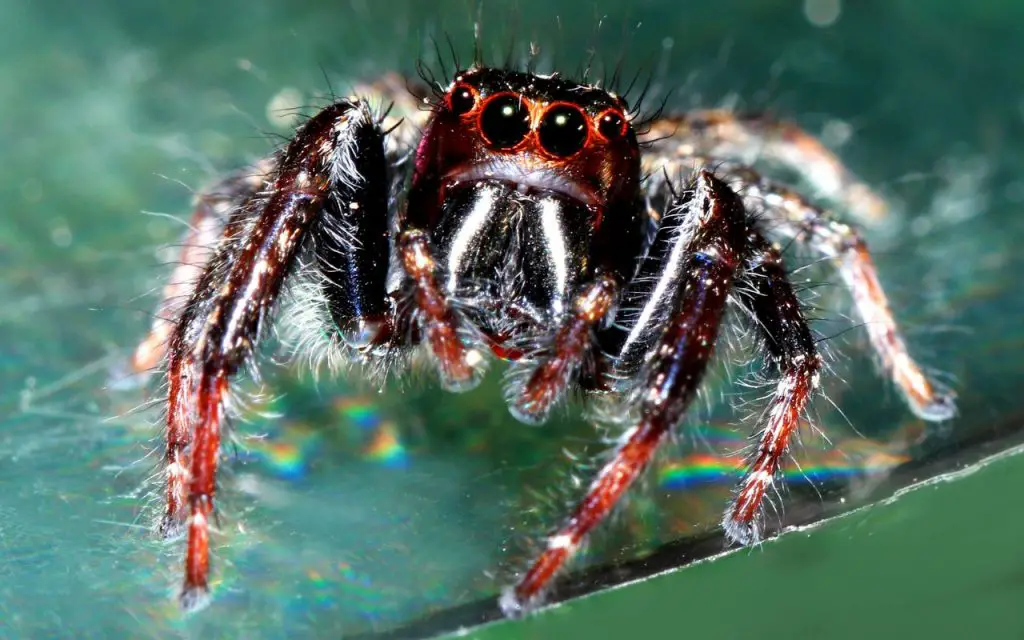
How often do jumping spiders eat?
Jumping spiders kept as pets require feeding every three days or so. Though it is not uncommon for older spiders to go for several weeks without food.
What do jumping spiders eat in the winter?
Since crickets and flies are always around, most pet jumping spiders continue to prefer them as food throughout the season. They may either receive crickets you purchase for them or crickets you catch around your home.
Similar to that, a few mealworms can also be an additional food source and provide them with the necessary nourishment. Remember to remove the mealworms from the tank if the spiders do not consume them, otherwise, they’ll develop into beetles, which can be harmful to spiders.
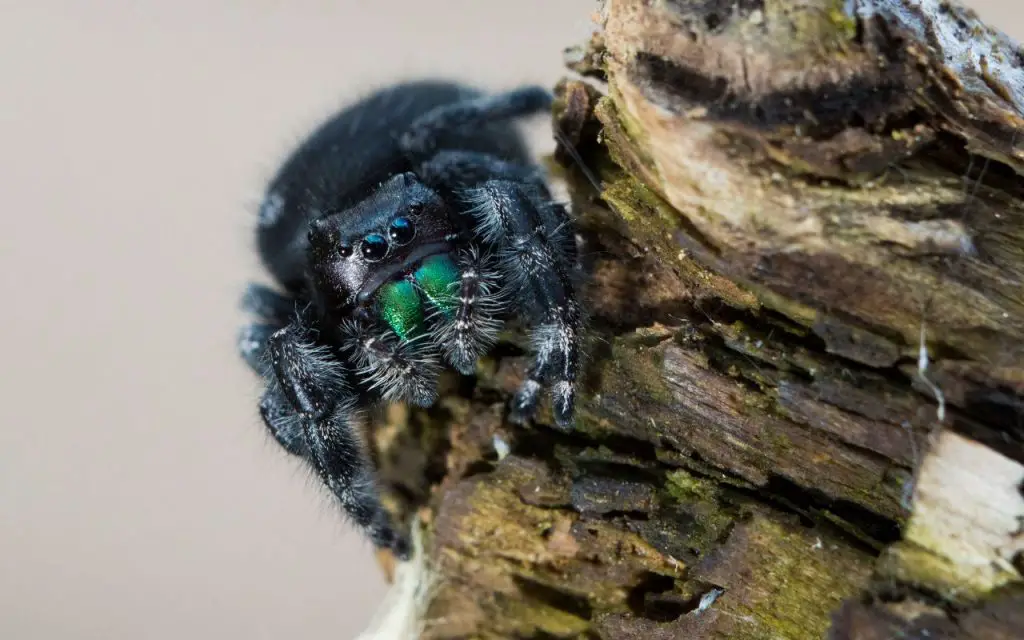
Do jumping spiders drink water?
Food, high humidity, and the mist in their enclosures provide water for captive jumping spiders. To keep your spider hydrated and healthy, these three sources must be balanced.
You may use a bottle cap as a small bowl. Small water dishes can act as a direct water source and raise the humidity in their enclosure.
FAQ relating to what baby jumping spiders eat
Here are some frequently asked questions related to what baby jumping spiders eat:
How do you take care of a baby jumping spider?
Here are the steps to take care of your spider:
1. Catch the spider
Carefully catch the spider from your surroundings using a cup or a small container. If you get bit during the process and develop allergic reactions, take medical help immediately.
Jumping spiders usually lives on tree branches and spend a lot of time on foot. Its dark brown and gray color blends nicely with tree bark.
If you stay in eastern North America, you’ll find large male and female regal jumping spiders there, in relatively open areas. Phidippus audax or bold jumping spider is also common in Northern America.
Phidippus otiosus is a jumping spider species from Southeastern North America. Jumping spiders have a variety of natural habitat, including tropical forests, tall grasses, deserts, etc.
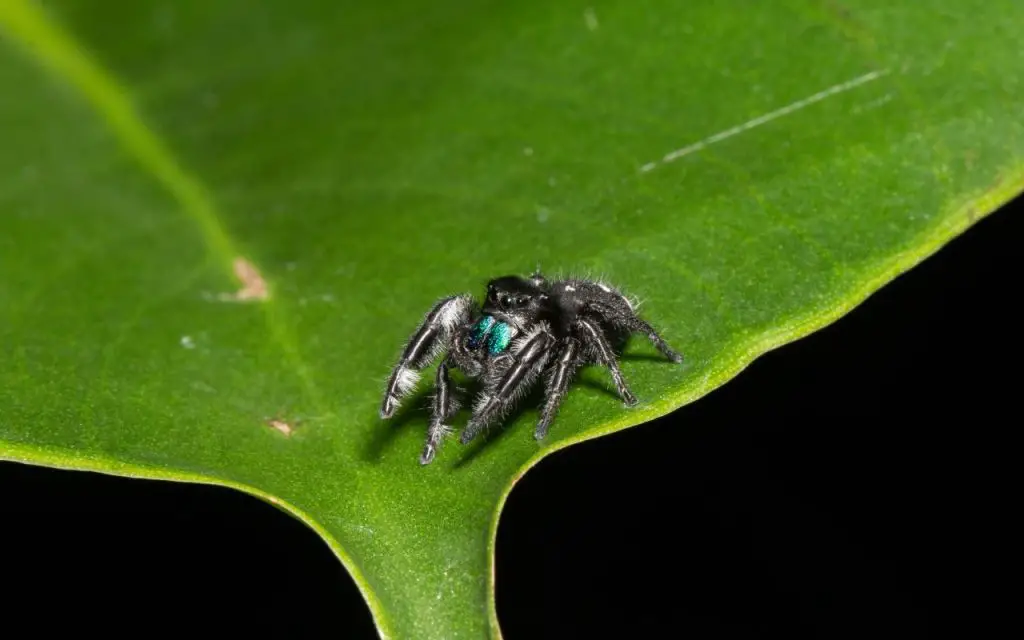
1. Establish a secure environment
Baby jumping spiders may survive and even flourish in a range of settings. Try to pick a toxic-free container that is at least one cubic foot in size to ensure they have room to leap.
- The best way to ensure that your spider receives enough airflow, make sure the lid is ventilated with tiny holes. Although jumping spiders don’t make webs, they do like to take naps in little nests.
- Make a bed for your pet spider by giving it some materials. It’s a good idea to pick a little scrap of fabric or perhaps a paper towel for your little guy.
- Keep the cage out of the sun’s direct rays. Avoid letting your spider become too hot.
Check out the options below for housing your pet:
2. Give your spider food
Your exotic pets will get hungry as soon as they emerge from the mother’s egg sac. That is the best time to feed them, otherwise they’ll eat each other.
Finding extremely tiny insects is the only way to raise young spiders. If you are unable to locate pet shops that carry them, you may also get them online.
Try giving your spider enough food, including little bugs and flightless fruit flies to eat. The majority of pet stores sell the food if you don’t want to gather it yourself.
It’s not necessary for your spider to eat every day. If you give it a bug every two to three days, it will be fine.
Drop the bug into the cage with ease. Your baby jumping spider will grasp it using front legs and consume the prey.
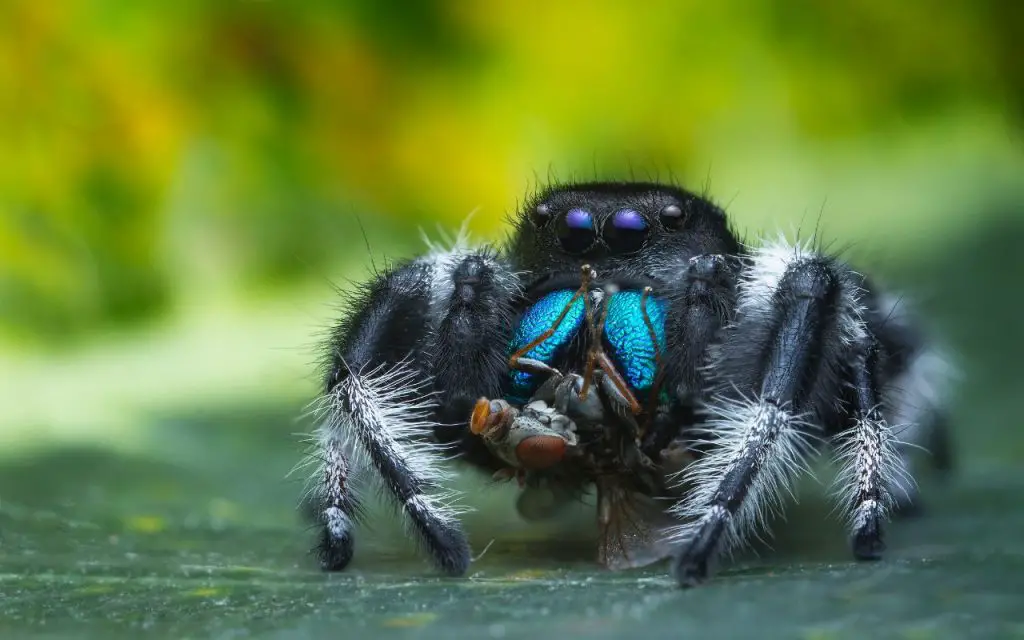
3. Water your pet
Every day, a jumping spider will typically drink, but you might not always see it. Don’t be deceived – they require some water daily.
They are quite susceptible to desiccation, like all spiders. Pay close attention to how active your jumping spider is.
If it starts to lag, there could be a problem. You must keep in mind that they do need water to survive, so the most important thing is to give them water in right quantity.
Spiders have organs in their abdomens known as book lungs that allow them to breathe. It does not breathe through any structures in its head as some creatures do.
There lungs resemble book pages. A spider may drown if water was applied to its abdomen because it might seep between the “pages” and suffocate.
You’ll only require very little water droplets for spiders. A tiny spray of water mist every few days on the side of the cage should be sufficient if you have a misting bottle.
If not, trickle a few drops onto the cage’s side. Don’t form any puddles, otherwise your spider could go into trouble.
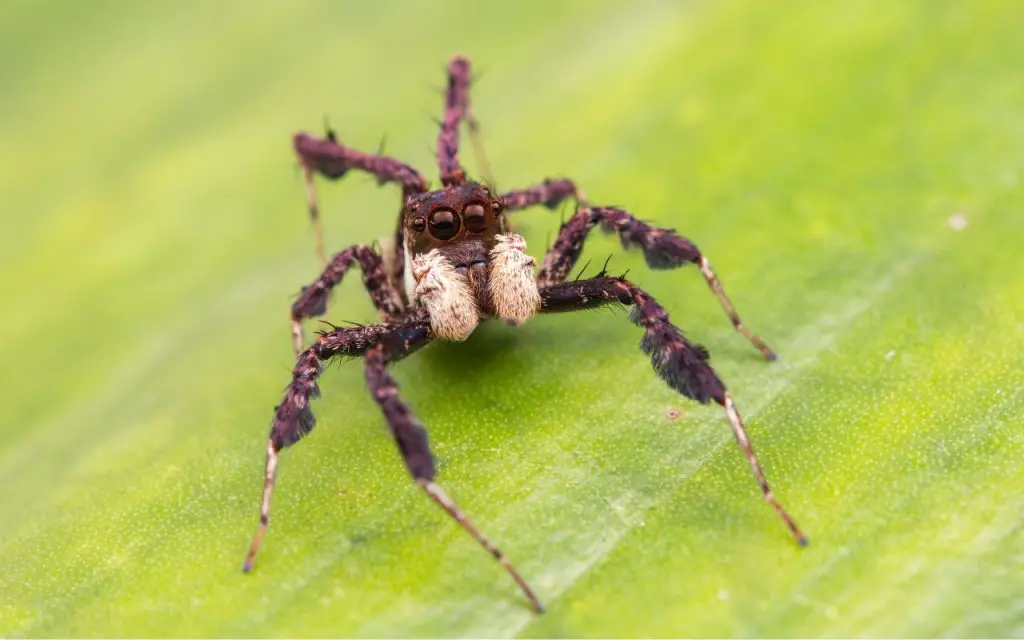
4. Gently handle your spider
This cute pets with large eyes dislike being handled or touched in any way. If you must transfer him, attempt to push him into a cup with the aid of a piece of plastic or another object.
Watch it bounce about in his cage. If you carefully trace your finger around the container’s walls, the spider will also follow.
You can occasionally free your spider from captivity. Watch it leap when you place the spider on your desk, but be cautious not to lose it.
5. Record details
Try recording details, including when eats, how much it consumes, and any changes to its body length or color. You may monitor when it prefers to sleep as well.
Keep a tiny notepad close to the cage where you keep your baby jumping spider. You’ll have it close at hand that way when you see it doing anything interesting.
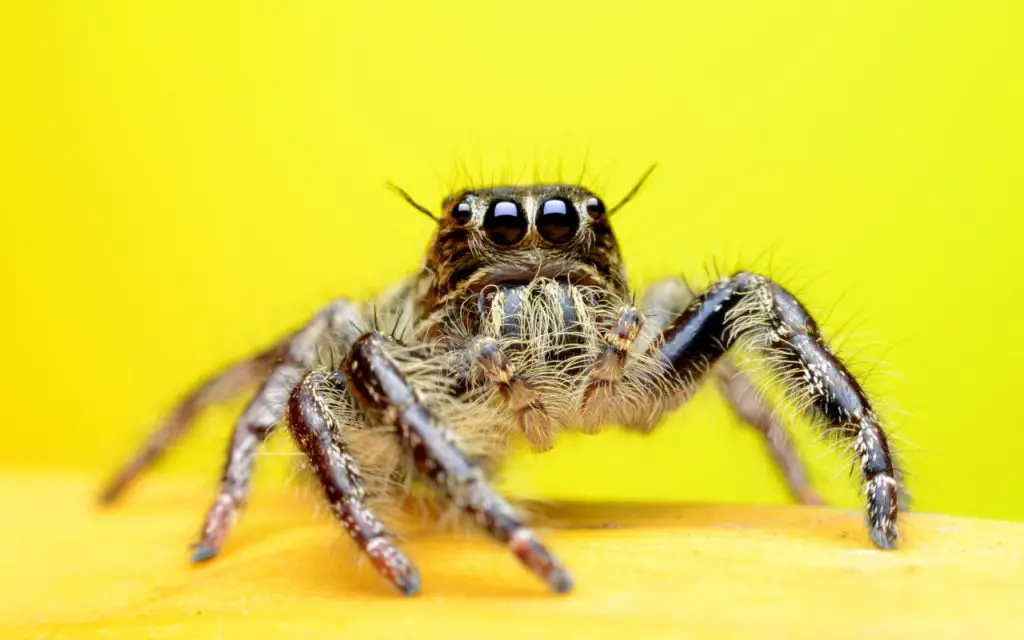
How long can baby jumping spiders go without food?
Baby jumping spiders can go without food for two to three days. But they need to drink water every day.
What do small baby spiders eat?
Small baby spiders consume mother’s milk for the first 20 days. After that, they eat small insects and mother’s milk.
Do jumping spiders need a water dish?
Although jumping spiders may drink from a tiny water dish, such as a plastic bottle cap, they frequently prefer to use mist spray. It prevents them from having to take the chance of falling to the bottom of their cage.
Because of this, misting spraying the edges of the spider’s enclosure every few days is helpful. But remember to stay away from spraying the spider directly because they don’t like it.

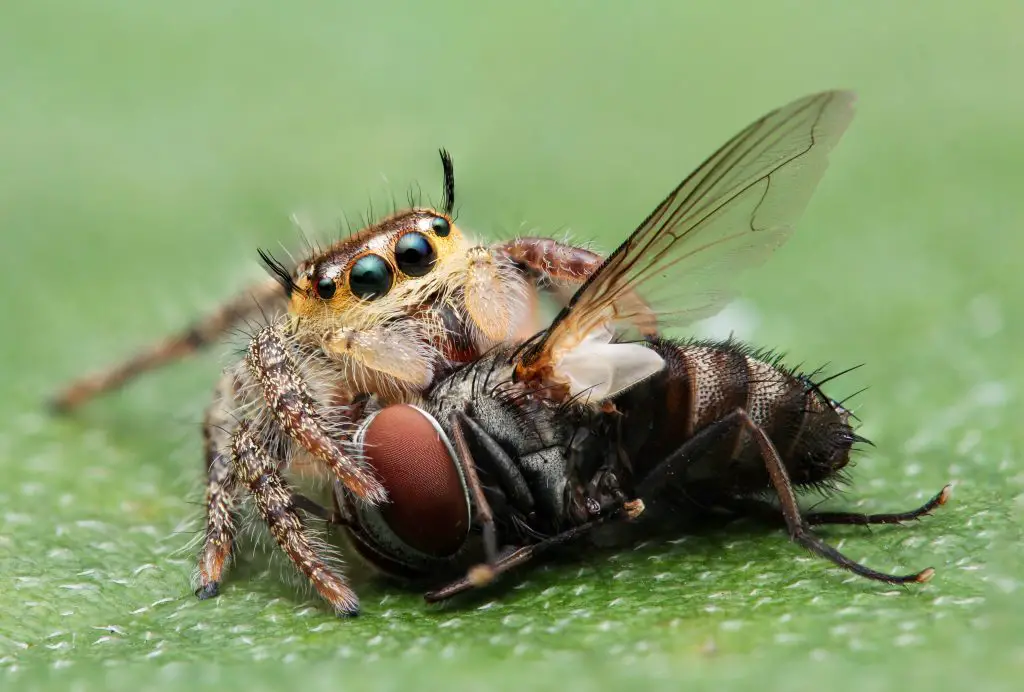
 Zilla Micro Habitat Terrarium
Zilla Micro Habitat Terrarium Micro Habitat Terrarium 8x6x14 inch
Micro Habitat Terrarium 8x6x14 inch